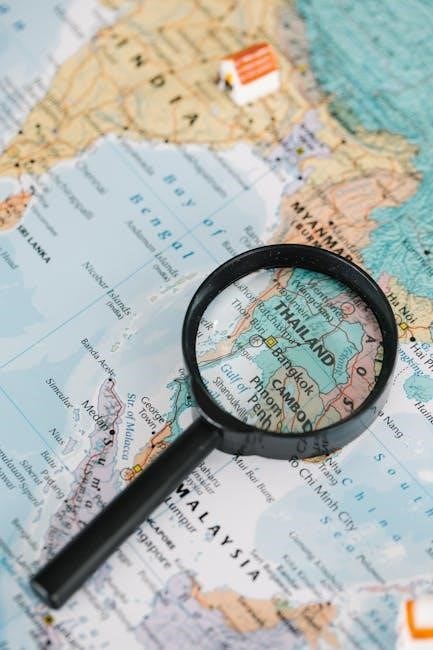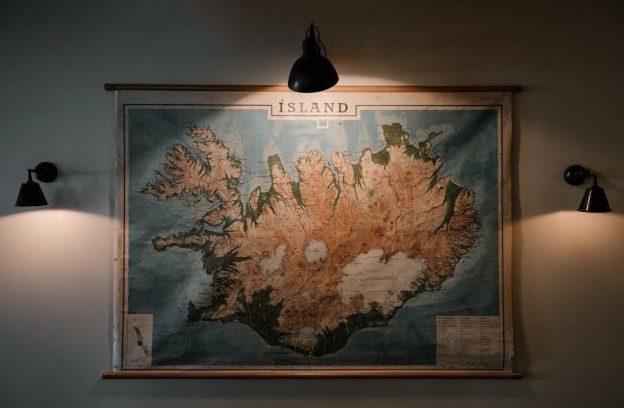Lord of the Flies, by William Golding, tells the story of British schoolboys stranded on a deserted island after a plane crash. Ralph, the elected leader, strives to maintain order, while Jack’s desire for power leads to chaos. The novel explores themes of civilization, savagery, and human nature through their struggles, ultimately revealing the darkness within when societal constraints fade.
1.1. Plot Overview
The novel begins with a group of British schoolboys stranded on a deserted island after a plane crash. With no adult supervision, the boys attempt to govern themselves, electing Ralph as their leader. Initially, they work together to build shelters and maintain order, guided by the conch shell, which symbolizes democracy and the right to speak. However, tensions rise as Jack, who desires power, becomes obsessed with hunting and controlling the group. The boys’ behavior deteriorates, and their civilized demeanor gives way to savagery. The story unfolds with key events like the discovery of the “beast,” the death of Simon, and the tribe’s eventual division. The novel ends tragically, with Ralph being hunted by Jack’s tribe, until they are rescued by naval officers, restoring order but highlighting the loss of innocence.
1.2. Key Events and Turning Points
The novel’s pivotal moments shape the boys’ descent into chaos. The first major event is the election of Ralph as leader, symbolizing order and democracy. The discovery of the conch shell establishes a rule for speaking, but its power wanes as the group’s behavior deteriorates. Jack’s obsession with hunting and his eventual rebellion against Ralph mark a turning point, dividing the group. Simon’s murder, mistaken as the “beast,” is a tragic climax, highlighting the boys’ savagery. Ralph’s pursuit by Jack’s tribe and the rescue by naval officers conclude the story, underscoring the loss of innocence and the fragility of civilization. These events collectively illustrate the transformation from innocence to savagery, central to Golding’s exploration of human nature.

Characters and Their Roles
Ralph, Jack, Piggy, and Simon are central figures, each representing distinct values. Ralph embodies leadership and order, while Jack symbolizes power and savagery. Piggy, the voice of reason, and Simon, the moral compass, influence the group’s dynamics. Minor characters like Roger and Samneric add depth to the narrative, highlighting the struggle between civility and primal instincts.
2.1. Major Characters: Ralph, Jack, Piggy, Simon
Ralph, the protagonist, is a natural leader who represents order and democracy. He is fair-haired, handsome, and initially optimistic about their survival. Jack, in contrast, is power-hungry and aggressive, symbolizing savagery. His desire to hunt and control the group drives the plot’s tension. Piggy, the intelligent and rational thinker, acts as the voice of reason, emphasizing the importance of rules and civilization. Simon, the quiet and insightful boy, discovers the truth about the “beast” and embodies moral clarity. Together, these characters illustrate the conflict between civility and primal instincts, shaping the novel’s exploration of human nature.
2.2. Minor Characters: Roger, Maurice, Samneric
Roger, initially quiet and withdrawn, becomes increasingly aggressive, symbolizing the descent into savagery. He is loyal to Jack and contributes to the group’s violent actions. Maurice, another follower of Jack, participates in the group’s primal behavior, showing how peer pressure leads to moral decay. Samneric, twins who initially support Ralph, eventually succumb to fear and join Jack’s tribe, highlighting the fragility of loyalty under pressure. These minor characters illustrate how individuals adapt to the island’s lawless environment, contributing to the novel’s exploration of human nature and societal breakdown.

Themes and Symbolism
The novel explores civilization vs. savagery, highlighting humanity’s primal instincts without societal constraints. The conch shell symbolizes democracy and order, while fear and paranoia drive irrational behavior.
3.1. Civilization vs. Savagery
The central theme of Lord of the Flies revolves around the conflict between civilization and savagery. Ralph represents civilization, advocating for rules, order, and the conch shell’s democratic power. In contrast, Jack embodies savagery, prioritizing hunting and power over collective well-being. As the novel progresses, the boys’ behavior descends into chaos, revealing their primal instincts. The island’s isolation strips away societal norms, exposing the inherent human tendency toward violence and domination. Golding illustrates that without external constraints, civilization is fragile, and savagery prevails, highlighting the darker aspects of human nature. This theme is reinforced through the boys’ actions, such as their fear of the “beast” and their eventual embrace of tribal mentality.
3.2. The Conch Shell and Its Significance
The conch shell is a powerful symbol in Lord of the Flies, representing order, democracy, and civilization. Found by Piggy, it is used to summon meetings and ensure the right to speak, fostering unity among the boys. Ralph and Piggy rely on it to maintain structure, while its influence wanes as the group descends into chaos. The conch signifies the boys’ connection to societal norms and their ability to govern themselves. Its destruction in the final chapters marks the end of their civilized behavior, highlighting the collapse of their moral framework.

Study Questions and Answers
Why is Ralph chosen as leader? Ralph is chosen due to his charismatic presence and the support of Piggy. What does the conch symbolize? It represents order and democracy. How does the group eventually rescue? A naval officer rescues them after seeing the fire. Why does Jack start his own tribe? Jack seeks power and control. What is the significance of Simon’s death? It marks the end of innocence and reason on the island.
4.1. Chapter-Specific Questions

- Chapter 1: Who is elected as the leader of the group? Ralph is chosen due to his charismatic presence and the support of Piggy.
- Chapter 2: What rule is established regarding the conch shell? The conch shell is used to ensure only one person speaks at a time, maintaining order.
- Chapter 3: What does the pig’s head symbolize? The pig’s head represents the “Lord of the Flies,” embodying the evil within humans.
- Chapter 4: How does Jack’s behavior change? Jack becomes more aggressive, focusing on hunting and power, showing a shift toward savagery.
- Chapter 5: What is Simon’s realization? Simon discovers the “beast” is a dead pilot, revealing the true nature of their fears.
- Chapter 6: Why does Simon die? Simon is killed by the boys in a frenzied ritual, marking a tragic loss of innocence.
4.2. Essay Questions and Analysis
- How does the conch shell symbolize order and democracy in the novel? The conch shell represents civilization and fairness, allowing only one speaker at a time, but its power fades as savagery prevails.
- Analyze the conflict between Jack and Ralph. Their rivalry symbolizes the clash between savagery and civilization, with Jack embracing primal instincts and Ralph striving to maintain moral order.
- What role does Simon play in revealing the novel’s themes? Simon’s discovery of the “Lord of the Flies” exposes the true nature of humanity, highlighting the inherent evil within the boys.
- Discuss the significance of the beast as a symbol. The beast represents the boys’ collective fears and the unknown, reflecting their primal instincts and loss of innocence.
- How does the island transform the boys’ behavior? The absence of adult supervision unleashes their darker impulses, revealing the fragility of civilization and the rise of savagery.

Literary Devices and Techniques
Golding employs allegory to depict human nature through the boys’ actions, while irony underscores the contrast between their civilized intentions and primal instincts, enhancing the novel’s thematic depth.
5.1. Imagery and Foreshadowing
William Golding uses vivid imagery to depict the island’s beauty and the boys’ descent into savagery. The conch shell, symbolizing order, is described with precision, while its fading significance mirrors the group’s chaos. Imagery of the island’s lush landscapes contrasts with the boys’ violent actions, emphasizing the clash between nature and humanity. Foreshadowing is evident in Simon’s vision of the pig’s head, hinting at his tragic fate, and in the boys’ fear of the “beast,” which symbolizes their inner darkness. The use of fire, both as a tool and a destructive force, foreshadows the island’s eventual devastation. These techniques create tension and depth, guiding readers to reflect on the novel’s themes of civilization and primal instincts.
5.2. Allegory and Irony
Lord of the Flies is rich in allegory, with the island representing a microcosm of society. The boys’ actions and conflicts symbolize human nature’s duality, exploring how quickly civilization can unravel. The conch shell allegorically represents democracy and order, while the beast symbolizes the fear of the unknown and inner evil. Irony is evident when the boys, initially fearing a mythical beast, become the true monsters. Jack’s transition from a choirboy to a savage leader is a stark example of ironic character development. The novel’s ending, where Ralph is rescued but the island burns, ironically highlights the cyclical nature of destruction. These elements deepen the narrative, inviting readers to reflect on humanity’s inherent flaws and the consequences of unchecked power.

Historical and Cultural Context
Lord of the Flies was written by William Golding in 1954, reflecting post-WWII societal concerns. The novel critiques human nature, drawing from Golding’s wartime experiences and Cold War anxieties, exploring civilization’s fragility and the inherent savagery within humanity, resonating with 20th-century philosophical debates on morality and governance.
6.1. Context of the Novel’s Publication
Lord of the Flies was published in 1954 by William Golding, a British author and former naval officer. The novel emerged during the post-World War II era, a time of heightened awareness of humanity’s capacity for violence and societal collapse. Golding’s experiences in the war deeply influenced his writing, shaping the novel’s themes of savagery and the breakdown of civilization. The Cold War context also played a role, as the world grappled with fear of nuclear destruction and the fragility of human morality. The novel’s release coincided with a growing interest in existentialism and psychological exploration in literature. Its publication was met with critical acclaim, sparking debates about human nature and governance. The timing of its release allowed it to resonate with a society questioning the moral frameworks established after the horrors of WWII.
6.2. Relevance to Modern Society
Lord of the Flies remains highly relevant to modern society, offering insights into human nature, group dynamics, and the effects of fear and power struggles. Its exploration of bullying, violence, and the breakdown of morality resonates with contemporary issues like school violence and social media-driven conflicts. The novel’s themes of leadership, governance, and the fragility of civilization align with modern debates on political polarization and societal fragmentation. Additionally, its portrayal of primal instincts and survival instincts mirrors real-world concerns about environmental degradation and resource scarcity. The novel serves as a cautionary tale about the dangers of unchecked ambition and the importance of empathy, making it a timeless study of human behavior in crisis situations.
